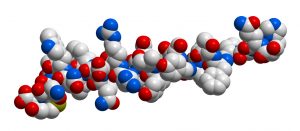
Peptides are short chains of amino acids, and can be thought of as smaller versions of proteins, which are also made up of linked amino acids. Peptides have been identified as and are increasingly utilized in several scientific areas.
Peptides can be used to isolate protein antibodies in animal research, or small, synthetic peptides can be used to test protein interaction with other peptides. Recently peptides are also being studied as potential candidates for use in treating prostate cancer by inhibiting the uptake of growth hormones.
Researchers are beginning to understand the possibilities inherent in peptide experimentation. As such, peptides are increasingly in demand and under elevated levels of scrutiny by regulatory authorities. Key among the decisions that researchers make during experimental design is the source of their peptides. Peptide manufacturer selection is crucial, as it can significantly affect the outcome of an experiment if the test substance is impure or diluted.
In this highly competitive research landscape, American-made peptide manufacturers are differentiating themselves in a variety of ways, and are standing out as the producers of the highest-quality research-grade peptide products currently available. Put simply, among the other reasons for choosing an American peptide manufacturer is the notion that the scientist, with a US-made peptide test substance, researchers can expect:
1) Rigorous Certification:
All peptide manufacturers in the United States are required to undergo a rigorous and thorough assessment of manufacturing processes to ensure only the highest quality product is produced. This assessment, which usually results in a standing and renewable certification for the manufacturer, ensures that all purchasers know and are comfortable with the standards under which the manufacturer operates.
2) Testing and Auditing:
Similar to the certification process, which establishes that a manufacturer operates under guidelines at least as stringent as the baseline of the certification requirements, testing and auditing procedures are performed on US peptide labs to ensure quality as well. Despite clean facilities and good intentions, processes, procedures, and equipment can drift from their originally intended uses, resulting in errors and contamination. Regular testing and auditing as required by US regulatory agencies will ensure that there is no drift.
3) Supporting American Science:
In a world where cost is often the bottom line, US-made peptides are produced in the United States by American scientists. Not only does your purchase of US-made peptides ensure the continued viability of manufacturing in the United States, but it also supports science and educational research initiatives both by employing trained American scientists and by making US-produced peptides available to American researchers for testing and experimentation.
4) Dilution:
US-made peptides are as strong and potent as researchers might expect. One concern for manufacturers outside the United States is reduced oversight, which can lead to significant cost avoidance in the form of product dilution; making the product less potent by adding other agents influences the research being done in potentially catastrophic ways.
5) Shipping and Customer Service:
Manufacturers of peptides outside the United States may cost less, but purchasing peptides from US-based manufacturers often results in drastically reduced shipping fees and shipping times, with your peptides ending up in your hands more cost-effectively and in a more timely manner than other solutions outside the United States. Additionally, many US manufacturers provide US customer service solutions to their customers.
6) The Process:
The best of the best of United States peptide producers utilize not only American raw materials, but also American equipment and American packing materials. Each of these components undergoes the same stringent quality standards, resulting in a purer and purer end product.
7) Purity:
In order to be confident of experimental results, purity is key. Contamination by other substances can be harmful to the research being done, and can introduce errors or distracting results into a study. The rigorous American certification processes undergone by US manufacturers ensure that product purity will be of the highest order possible and exactly as advertised.
For many researchers, cost is the bottom line when determining study design and the application of funding. But ensuring that only US-produced peptides are used in research represents a valuable investment in the integrity of data and of the results, and in the end can prove much more valuable.



